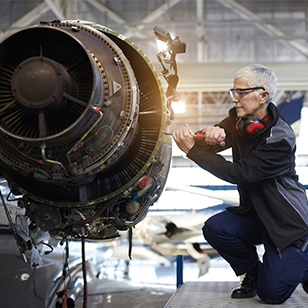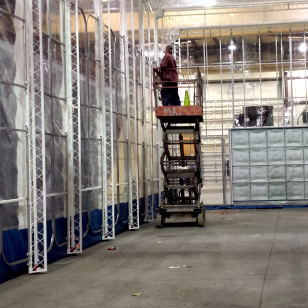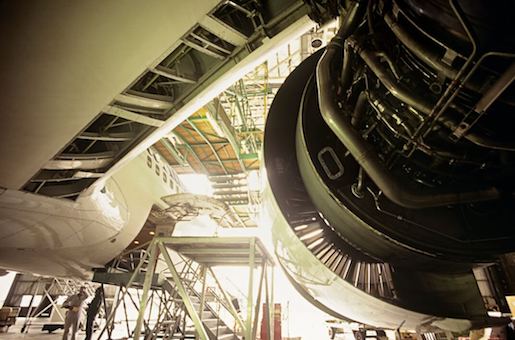Protecting Aircraft Presents Indoor Air Risks for Employees
From F-16 fighter jets to space craft, mission-critical manufacturing operations face a common threat: corrosion. It is the silent invader that can find its way into an aircraft, often undetected, until it causes catastrophic system failure. In addition to the obvious safety issues, corrosion damage can cost millions in aircraft repairs, rework, and repeated inspections.
According to the Aviation Safety Bureau, metal corrosion is caused by contact with chemical or electrochemical agents, such as acids, alkalis, and salts. The most common culprit is salt air which can quickly damage an aircraft and threaten pilot safety in oversea flights. Warning signs include discoloration of the metal’s surface, which can be gray, white, green, or the most commonly-known rust red. This discoloration indicates metal weakening that can lead to cracks.
It only takes a small rust blemish on an aircraft wing or crew entrance floor panel for this damage to spread to key components of an aircraft, including:
- Wing flap and spoiler recesses
- Battery compartments
- Bilge areas
- Bulkheads
- Engine nacelle cowlings
- Wheel wells and landing gear
Aerospace and aviation manufacturers, as well as military and defense contractors, rely on special coatings and paints to protect against these corrosive threats during flight. Unfortunately, the same chemicals that make these coatings impervious to salt and moisture are exceptionally dangerous when inhaled by manufacturing and maintenance employees.
Indoor Air Threats for Aircraft Sanding, Painting & Coating
Aircraft and other military machinery coatings often contain toxic hexavalent chromium, isocyanates, and VOCs that are released during sanding, coating, and painting processes. Corrosion maintenance, repair, and prevention work often involves removing protective coatings, treating the metal and then repainting and refinishing with protective coatings, so workers may be exposed to airborne carcinogens and toxins in almost every step of the operation.
Aerospace workers face a host of health threats from hexavalent chromium and VOCs, such as skin and respiratory issues and cancer risks; they are among the most serious safety concerns in all of manufacturing. There are stringent EPA and OSHA requirements for handling materials and facility-wide air quality.
The presence of isocyanates and hexavalent chromium in the protective coatings requires manufacturers to have a certified program for removing and applying the chemicals, including:
- Provide showers and separate lockers to ensure workers and their street clothes are free of the potential contaminants.
- Document how many hours the employees are around the chemicals and the specific type of isocyanide they were around.
- Provide cardiopulmonary tests every 6 to 12 months to monitor breathing.
Aircraft Corrosion Maintenance, Prevention Creates Logistical Challenges
Protecting employees from these hazards in corrosion repair and maintenance can pose costly logistical challenges associated with air hazard containment. For example, a major defense contractor did its aircraft painting in a hangar, which meant it could not be used by any other personnel for other work while painting was in progress.
Safeguarding employees from indoor air quality threats often required additional workflow delays, such as airing out an aircraft hangar after sanding, coating, or painting large jet components. Workflows could not continue until the hangar was deemed safe for employees to re-enter.
Having a dedicated area for sanding, painting, and coating was not a cost-effective option, as it required extensive material handling and man-hours. Plus, it would compound the labor required to clean up the sand and dust from previous deployments.
Indoor Clean Air Solutions Essential for Aircraft Painting & Coating
Duroair worked with the contractor to install two paint booths in the hangar so they could isolate the process and not lose access to the entire workspace. Duroair provided them with a modular/retractable enclosure with a four-stage filter dust collection system, so they could sand without contaminating the entire indoor environment. They got their workspace back when they didn’t have to sand.
This clean air filtration technology can isolate corrosion-related processes and capture all hexavalent chromium and VOC particles, then recirculate safe, clean air into indoor workspaces without expensive air makeup. Duroair clean air solutions significantly surpass EPA and OSHA requirements to capture more than 99% of the toxic particles.
Duroair can custom-engineer industrial air filtration solutions and clean rooms to cost-effectively shield workers from airborne carcinogens and toxins while meeting your compliance needs. Each modular Duroair booth can:
- Serve as an all-in-one sanding, coating, and painting booth where workers simply change out filters for each task.
- Break down in hours to be shipped and quickly re-deployed to another facility, to keep multi-facility production on schedule.
- Provide additional floor space and flexibility to take on new contracts without having to increase real estate.
Solve Your Corrosion Maintenance
Corrosion repair and maintenance is a vital aspect to ensure safety and high performance in the aviation industry. The right precautions are also essential for working with protective chemicals that are exceptionally dangerous when inhaled by manufacturing and maintenance employees.
Aviation, military, and defense manufacturers turn to Duroair for quick-deploy, cost-effective indoor air filtration. By bringing clean air to each workpiece, our custom-engineered solutions can save valuable man-hours and floor space, and prevent production bottlenecks. Contact our clean-air experts to learn more.


